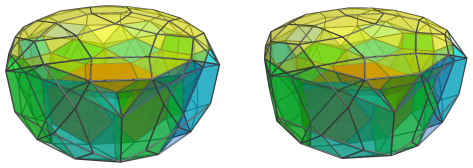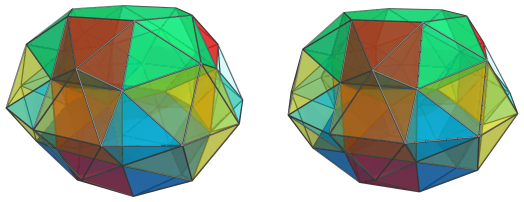4D Euclidean space
News Archive
May 2014
This month, we introduce the castellated rhombicosidodecahedral prism:
Discovered in February 2014, this CRF polytope is the first known non-trivial polytope that contains bilunabirotundae as cells. In spite of the unusual shape of the bilunabirotunda, its deep connection with the icosahedron allows 30 copies of it to close up in 4D in icosahedral symmetry, resulting in a polytope with 30 bilunabirotundae sandwiched between two rhombicosidodecahedra, with the remaining gaps filled by 12 pentagonal pyramids and 20 tetrahedra.
This discovery led to a series of further discoveries in the same month of many related CRF polytopes that sport bilunabirotunda and triangular hebesphenorotunda cells, leading some of the members of the tetraspace forum to dub February 2014 as “CRFebruary”.
So, head on over to the castellated rhombicosidodecahedral prism page and learn all about this polytope that started it all! As usual, the full Cartesian coordinates are provided.
29 May 2014:
Corrected numerous typos and other errors in several pages. Many thanks to John McIntosh for pointing them out!
2 May 2014:
The Polytope of the Month for May is up!
April 2014
This month, we have a special guest, the triangular hebesphenorotundaeic rhombochoron:
Known as the J92 rhombochoron for short, this is the first non-trivial CRF polytope known that has triangular hebesphenorotundae (J92) as cells. It was the second CRF polytope discovered that contained as cells one of the unusual Johnson solids near the end of Norman Johnson's list.
Previously, it was thought to be very difficult to build CRF polytopes out of these Johnson solids, because their unusual shapes were expected to cause polytopes that contain them as cells to be unlikely to close up in a CRF way, except in the trivial construction of their prisms. In February 2014, however, a CRF polychoron with icosahedral symmetry was discovered that featured bilunabirotunda (J91) as cells, dubbed the castellated rhombicosidodecahedral prism. This suggested that it may be possible to construct non-trivial CRF polychora with these unusual Johnson solids after all, especially the ones that showed some connection with the icosahedron, like J91 and J92. The J92 rhombochoron was discovered two days later.
Subsequently, numerous other 4D CRF polytopes have been discovered that contain either of these two Johnson solids as cells, sometimes both.
We chose the J92 rhombochoron as the Polytope of the Month for April because even though it was not the first polytope that featured unusual Johnson solids as cells, it was the first one that had J92 cells, and it also initially showed no obvious symmetry or relation to other known polytopes at the time. Recently, it has come to light that it may be connected to the rectified 600-cell via certain augmentations. But the details of that will come in their own time. For now, go to the J92 rhombochoron page and learn about the structure of this unusual CRF polychoron. Full coordinates are provided, as is customary.
2 Apr 2014:
The Polytope of the Month for April is up!






